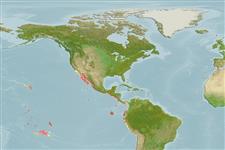sub class Elasmobranchii (ฉลามและกระเบน) (sharks and rays) >
Myliobatiformes (Stingrays) >
Dasyatidae (Stingrays) > Dasyatinae
Etymology: Dasyatis: Greek, dasys = rough, dense (Ref. 45335).
More on author: Garman.
Issue
This species is synonym of Dasyatis dipterura Jordan & Gilbert, 1880. See nomenclatural details in Eschmeyer (CofF ver. Oct. 2012: Ref. 92135). The species page will be removed.
Environment: milieu / climate zone / depth range / distribution range
นิเวศวิทยา
เกี่ยวกับทะเล,น้ำเค็ม สัตว์น้ำหน้าดิน; ระดับความลึก 1 - 70 m (Ref. 37955), usually 1 - 17 m (Ref. 9254). Subtropical; 42°N - 19°S, 161°W - 70°W
Eastern Pacific: Hawaii and from California, USA to Peru.
ขนาด / น้ำหนัก / Age
Maturity: Lm ? range ? - ? cm
Max length : 187 cm TL เพศผู้/กระเทย; (Ref. 40637); common length : 120 cm TL เพศผู้/กระเทย; (Ref. 9254); น้ำหนักสูงสุดที่มีการรายงาน: 46.3 kg (Ref. 40637)
Found in bays, in sea grass beds, kelp beds, and near reefs on sand and mud bottoms (Ref. 12951). Digs in the sand to feed (Ref. 5227). Feeds on small fishes, crabs, clams, and other benthic invertebrates (Ref. 37955). Ovoviviparous (Ref. 50449). Venomous spine on tail.
Life cycle and mating behavior
วัยเจริญพันธุ์ | การสืบพันธุ์ | การวางไข่ | เซลสืบพันธ์ของเพศเมีย(ไข่) | ความดกของไข่ | ตัวอ่อน
Exhibit ovoviparity (aplacental viviparity), with embryos feeding initially on yolk, then receiving additional nourishment from the mother by indirect absorption of uterine fluid enriched with mucus, fat or protein through specialised structures (Ref. 50449). Distinct pairing with embrace (Ref. 205).
Nishida, K. and K. Nakaya, 1990. Taxonomy of the genus Dasyatis (Elasmobranchia, Dasyatidae) from the North Pacific. In: Pratt Jr., H. L., S. H. Gruber and T. Taniuchi (eds.): Elasmobranchs as living resources: advances in the biology, ecology, systematics, and the status of the fisheries. NOAA (National Oceanic and Atmospheric Administration) Tech. Rept. NMFS 90:327-346. (Ref. 7445)
IUCN Red List Status (Ref. 130435)
Threat to humans
Venomous
Human uses
การประมง: มีการค้าเพียงเล็กน้อย; สถานที่แสดงสัตว์และพืชน้ำ: สถานแสดงสัตว์น้ำของรัฐ
ข้อมูลเพิ่มเติม
ชื่อสามัญชื่อพ้องกลไกการเผาผลาญพลังงานผู้ล่าการศึกษาเกี่ยวกับผลกระทบของสารประกอบทางเคมีที่เป็นอันตรายต่อสิ่งมีชีวิต ประชากร และสิ่งแวดล้อมการสืบพันธุ์วัยเจริญพันธุ์การวางไข่การรวมกลุ่มวางไข่ความดกของไข่เซลสืบพันธ์ของเพศเมีย(ไข่)Egg development
อ้างอิงการเพาะเลี้ยงสัตว์น้ำประวัติการเพาะเลี้ยงสัตว์น้ำสายพันธุ์พันธุศาสตร์ElectrophoresesอัตราพันธุกรรมโรคการแปรรูปNutrientsMass conversion
เครื่องมือ
Special reports
Download XML
แหล่งที่มาจากอินเตอร์เน็ต
Estimates based on models
Preferred temperature (Ref.
123201): 19.1 - 28.9, mean 24.2 °C (based on 317 cells).
Phylogenetic diversity index (Ref.
82804): PD
50 = 0.5002 [Uniqueness, from 0.5 = low to 2.0 = high].
Bayesian length-weight: a=0.00646 (0.00265 - 0.01571), b=3.06 (2.86 - 3.26), in cm total length, based on LWR estimates for this (Sub)family-body shape (Ref.
93245).
ระดับชั้นอาหาร (Ref.
69278): 3.8 ±0.60 se; based on food items.
ความสามารถในการกลับคืนสู่ปกติ (Ref.
120179): ต่ำ, เวลาต่ำสุดที่จะทำให้ประชากรเพิ่มขึ้นเป็น 2 เท่าใช้เวลา 4.5 - 14 ปี (Assuming fecundity<100).
Fishing Vulnerability (Ref.
59153): Very high vulnerability (90 of 100).
Nutrients (Ref.
124155): Calcium = 8.57 [1.15, 169.73] mg/100g; Iron = 0.64 [0.06, 7.72] mg/100g; Protein = 21.3 [18.9, 23.9] %; Omega3 = 0.179 [0.059, 0.499] g/100g; Selenium = 25.8 [5.2, 131.9] μg/100g; VitaminA = 3.34 [0.29, 35.44] μg/100g; Zinc = 0.41 [0.03, 5.00] mg/100g (wet weight);
